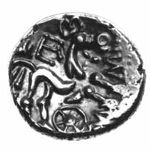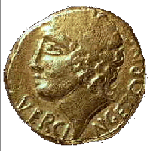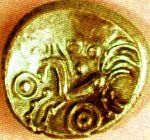I am copying ancient artifacts in order to get a feel for the design side of the world of War in Gaul. If I am going to make a comic of this story rather than to tell it in novel form, as was my original plan, I have to exploit the visual side of things, and preferably remedy that which annoys me so terribly in most visual renditions of the Celts in comics and films: the almost total neglect of their concern for appearance. I have to try and do justice to their fine workmanship - the beautifully decorated weapons, the fine fabrics, the colours, the refined jewellery, the elaborate hairstyles. It's going to take a lot of exercise!
 *****
*****
The bronze helmet on the left was found in northern Italy; it dates back to the third century BC. The thingy on the top used to have a crest attached to it. All other helmets are from the first century BC, which is the epoch in which my story takes place. By that time, helmet-makers had apparently dispensed with crests and the smooth bowler hat-style was all the rage. The helmets of Roman legionaries were inspired on this type.
The large helmet with the bird decoration on the cheek pieces was found in former Yugoslavia. I'm very fond of it, and it's the only one for which I have found a definite owner in the story: on account of the bird, I'm giving it to Catuvolcos. Catu-volcos apparently translates as battle-falcon, and though the bird on the helmet is most obviously not a falcon, I think it sort of fitting :-).
A note on the medium:
I used graphite and colour pencil, and made the drawings in my brandnew Moleskine reporter notebook. The paper is very smooth and light, and I believe it is to this that I owe my pleasing results with the colour. I tend to be not very accomplished working with colour pencils, but on this paper they glide and blend so nicely; it makes the notebook a good buy :D.
I used graphite and colour pencil, and made the drawings in my brandnew Moleskine reporter notebook. The paper is very smooth and light, and I believe it is to this that I owe my pleasing results with the colour. I tend to be not very accomplished working with colour pencils, but on this paper they glide and blend so nicely; it makes the notebook a good buy :D.
Most of the time when you see Celts on the screen, they are dirty, with wild masses of hair and dressed in dark and/or drab colours (Robin Hood, Prince of Thieves), single bits of animal skin (the first Astérix film), or in the case of Keira Knightly in King Arthur, a few leather strings *g*. The costume designer on Vercingétorix (released elsewhere as Druids) could be heard to claim that Celtic clothing was ragged because these peoples were lazy and not strong on finishings. What a funny thing to say, when most of the few bits of Celtic fabric we have left are seams and pieces of embroidery. If real Celts had seen what the dear lady made of Vercingetorix, they'd have assumed him to be a beggar rather than a prince.
Many people seem to assume that because we are talking about the ancients, their notion of what was beautiful must be entirely different from ours - but surely they, too, distinguished between scruffy and neat, dirty and clean. They, too, preferred combed and shiny hair to a tangled mess; we have recovered quite a few combs and hair ornaments, bog women with complex plaited hairdos, and in Celtic literature it is a sign of hospitality and affection to comb and cut another person's hair. They, too, valued cleanliness; Caesar reports that the Celts washed every morning (he seems to find that worth remarking on), and they are the people who invented soap (something the Romans didn't use). Celtic women used make-up, and some sources claim that men depilated their body hair. There are classical authors who assert that Celtic men would get fined if they were overweight - but of course that may be one of the stories they told to show what freaky foreigners these Celts were :-).
While watching the BBC series Rise and Fall of Ancient Rome recently, I paid special attention to the fabrics of the costumes, and to my surprise, the Romans did not receive a much better treatment than the Celts tend to get, though they were allowed a little more colour. I saw Nero, and just about every other rich Roman aristocrat, dressed in rough, stiff fabrics that I wouldn't have expected to see worn by such lovers of luxury. Either the costume designer had a small budget and was forced to make do with cheap stuff, or I was meant to believe that the ancients were incapable of weaving finer fabrics than that. Now - I know that the Celts' small sheep, at any rate, were half-wild and their wool not very soft. But lo: in the salt mines of Salzburg were found several samples of Celtic woollen fabric, and they are beautifully woven and smooth! With my untrained eyes I can't distinguish them in any way from samples of modern fabrics. Now, if a Celtic miner could have clothes made of smooth stuff, I bet Nero could too :D. We have such a weird way of looking at the past... I am bound to conclude that all in all we seem to think very, very highly of our modern selves *g*.
So there, I feel that I should try and show an approximation of the visual opulence of the Celtic aristocracy. That means lots of bright colours, ornament, jewellery, and decorated props. I am not usually inclined to draw such detail, but the Celts do deserve it :-). The nice thing is that I found, when I started drawing these helmets, that I enjoyed myself; that surprised me, because normally I am not interested in drawing objects - I prefer people. As I copied them, the beauty of these helmets dawned on me as never before; the Celtic craftsmen had such an eye for detail and balance that it is a true joy to try and render them in pictures. I am not sure how feasible it will prove to be in the long run, because I am very slow and my usual style is not very elaborate, but I am certainly determined to do my best with the clothes, the attributes, the houses and so on.
I don't know about colour yet. On the one hand it seems necessary. On the other, I'm not good at colouring :/. I guess much will depend on how much I manage to learn about colour and techniques while preparing the project.
So there, I feel that I should try and show an approximation of the visual opulence of the Celtic aristocracy. That means lots of bright colours, ornament, jewellery, and decorated props. I am not usually inclined to draw such detail, but the Celts do deserve it :-). The nice thing is that I found, when I started drawing these helmets, that I enjoyed myself; that surprised me, because normally I am not interested in drawing objects - I prefer people. As I copied them, the beauty of these helmets dawned on me as never before; the Celtic craftsmen had such an eye for detail and balance that it is a true joy to try and render them in pictures. I am not sure how feasible it will prove to be in the long run, because I am very slow and my usual style is not very elaborate, but I am certainly determined to do my best with the clothes, the attributes, the houses and so on.
I don't know about colour yet. On the one hand it seems necessary. On the other, I'm not good at colouring :/. I guess much will depend on how much I manage to learn about colour and techniques while preparing the project.













